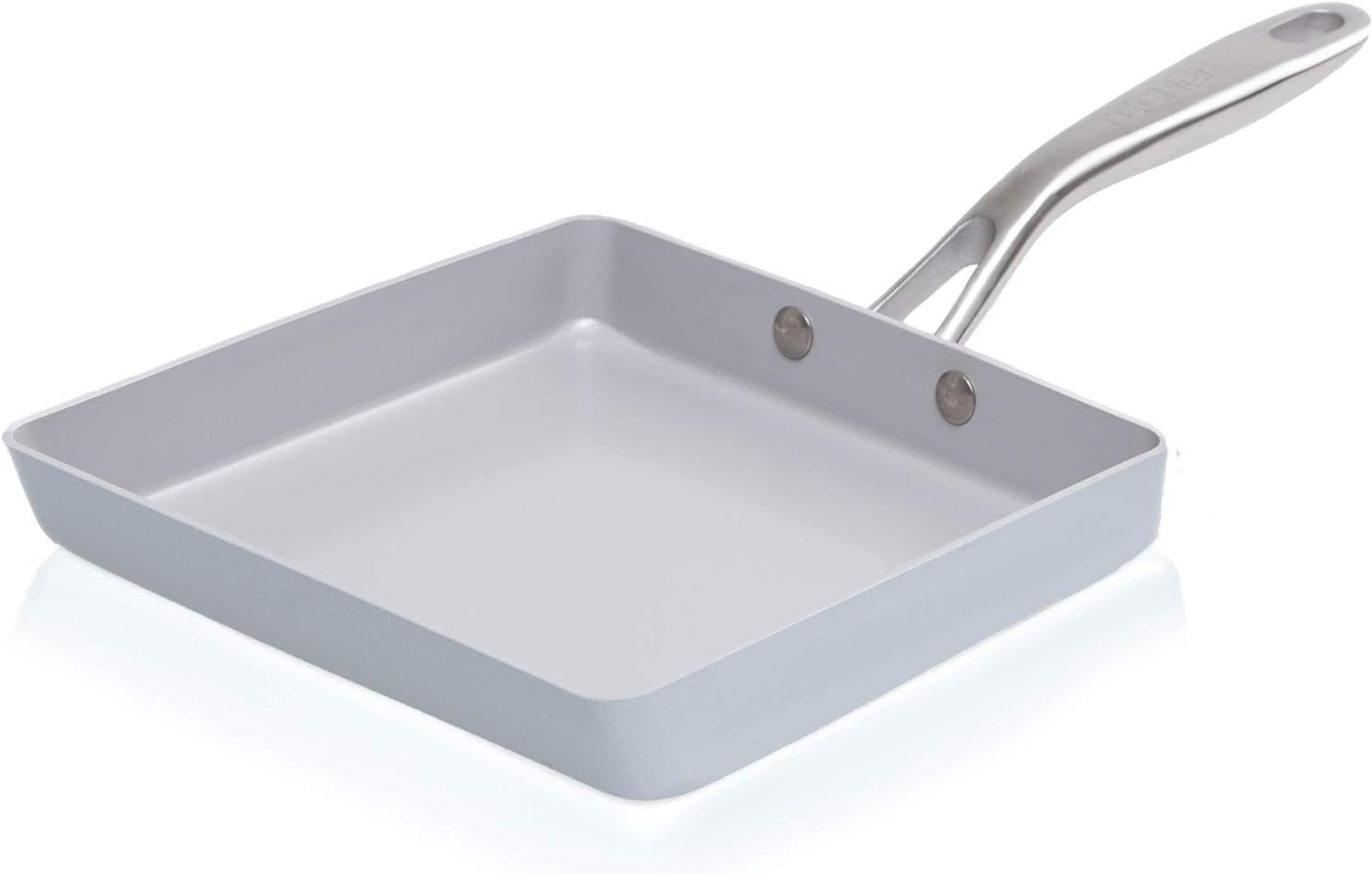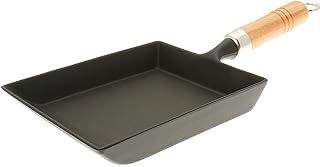Top Tamago Pan Picks for Perfect Japanese Omelettes

Key Highlights
Key Highlights:
- For a tamago pan that makes sure your omelettes come out smoothly without sticking, go for one with a nonstick coating. This feature helps in flipping and rolling them easily.
- With cast iron tamago pans, chefs get the benefit of even heat spread and holding onto heat well, which means your omelettes turn out just right.
- Choosing a carbon steel pan is also smart because it’s great at spreading and keeping the heat too.
- When you’re working on those layers in your tamagoyaki, using a silicone spatula is best to avoid any scratches on the pan surface while flipping or rolling.
- A rectangular-shaped tamagogoyaki pan is what you need if you want to achieve those signature layered rolls typical of tamagoyaki.
Introduction
Start your adventure into Japanese cooking with the must-have for any tamagoyaki lover – a tamago pan. Discover how to make the perfect rolled omelet by using the correct pan, ingredients, and methods. Jump into making Japanese omelets, where skill and creativity meet to whip up savory treats. Take your breakfasts to new heights and wow your loved ones with tasty homemade dishes crafted in your new Japanese egg pan. Plus, learn how to perfect your tamagoyaki shaping skills with the help of chopsticks. Let’s dive deeper into what makes tamago pans so special.
Understanding Tamagoyaki
Tamagoyaki, a classic Japanese cuisine item, is essentially an omelet that’s rolled up. Making it isn’t just about mixing eggs; it involves a bit of skill and practice to get right. You start with thin layers of egg mixture and carefully roll them one after the other in a special pan designed for this purpose. The key is to cook it over medium heat so everything cooks evenly without burning, giving you that soft texture everyone loves. Getting the hang of making tamagoyaki means getting familiar with its cooking technique – something at the heart of mastering this tasty dish.
The Art of Japanese Omelettes
In Japanese cuisine, making tamagoyaki is like creating a piece of art. It’s all about carefully cooking and layering thin egg sheets into a rectangular shape. With each layer, you aim for the perfect cook to bring out that ideal mix of juiciness, umami flavor, and a savory taste that makes your mouth water. Rolling these eggs just right turns an ordinary omelette into something extraordinary – it’s not just food; it’s an experience for your taste buds.
Essential Ingredients for Tamagoyaki
To make a real tamagoyaki, or Japanese rolled omelet, you’ve got to have some key stuff like eggs, soy sauce, mirin, and dashi. These ingredients work together to give it that special taste – umami – and make it nice and juicy. Getting the seasoning right is super important if you want your tamagoyaki to turn out great. This mix of flavors really shows what Japanese cuisine is all about and is crucial when learning how to whip up this dish.
Selecting the Perfect Tamago Pan
When picking out the perfect tamagogoyaki pan, think about whether you’d like cast iron or a nonstick type. Go for one with a rectangular shape to help roll your omelet just right. Make sure it’s big enough for what you need and made of something that heats up well and evenly. A pan that has a nonstick coating will not only make cooking simpler but also cleaning up afterward won’t be such a hassle. Your tamago pan should fit right in at large family breakfasts or when making special homemade dishes just for yourself or someone close. Making the best choice means nailing those Japanese omelettes every single time.
 | TECHEF - CeraTerra Ceramic Nonstick Tamagoyaki Japanese Omelette Pan/Egg Pan Skillet, (PTFE, PFAS, and PFOA Free), Dishwasher Oven Safe, Stainless Steel Handle, Induction-Ready |
Material Matters: Cast Iron vs. Non-Stick
When it comes to picking a tamagogoyaki pan, you’ve got two main options: cast iron and non-stick. With its top-notch heat retention and toughness, cast iron is great for cooking evenly and creating a firm texture in your omelets. On the other hand, if you’re just starting out, non-stick pans might be your go-to since they need less oil to make a lighter omelet. However, with time and use, cast iron pans can also become more non-stick. It really boils down to how you like to cook and what kind of care routine fits your lifestyle best. Both kinds can whip up tasty Japanese omelets; it’s all about what suits your personal taste and kitchen habits when choosing between the durability of cast iron or the ease of use that comes with non-stick surfaces.
Shape and Size: Finding the Right Fit
When you’re out looking for a tamagogoyaki pan, the shape and size are super important to make that perfect Japanese omelette. Aim for a rectangular shape because it helps with rolling up the omelette just like they do in Japan. You’ll want your pan to be small but also big enough so you can spread out a thin layer of egg mixture and cook it evenly in a rectangle shape. Choose a size based on whether you’re cooking for yourself or making bigger omelettes for more people. Getting the right shape and size really makes making tamagoyaki easier.
Top Tamago Pan Reviews
When looking for the best tamago pans, you’ll find a bunch that stands out for different reasons. There’s an all-around great pan known for doing lots of things well, options that won’t break the bank and are ideal for those just starting out, and high-end choices designed with serious cooks in mind. With each pan comes special features like lasting a long time, having nonstick surfaces, and being perfect at making rolled omelets. Picking the right tamago pan can really make your Japanese omelette-making game better and help you get good at creating tamagoyaki. In fact, finding the perfect tamago pan is our mission statement here at r/BuyItForLife.
The Best Overall Tamago Pan
The top tamago pan stands out because it spreads heat really well and has a surface nothing sticks to, making perfect Japanese omelets every single time. With its smart design, you can easily roll up the omelet using a silicone spatula, which is great for anyone just starting or those who know their way around the kitchen. Made with tough stuff like cast iron or carbon steel, this do-it-all pan delivers steady cooking results and is super easy to clean afterward. It’s definitely an upgrade worth considering if you’re keen on nailing the art of making tamagoyaki with its stainless steel magnetic bottom for easy storage.
Budget-Friendly Picks for Beginners
If you’re on a budget and just starting out, tamago pans that don’t stick are the way to go. They’re super easy to handle and clean up is a snap, which is great for anyone trying their hand at making Japanese omelets for the first time. With these nonstick pans, your rolled omelet won’t get stuck, and flipping it over becomes really simple. When shopping around, aim for ones with a strong nonstick coating, like a skillet, so you can cook with less oil. These kinds of pans are pretty easy to find without spending too much money, making them an awesome pick if you’re diving into the world of tamagoyaki.
Premium Options for the Serious Chef
For those who are really into cooking and want the best of the best, high-end Tamago pans are where it’s at. With options like copper or carbon steel cookware, including the popular copper pan, you can take your food to new heights. These pans make sure heat spreads out evenly which is super important when you’re trying to nail a perfect Tamagoyaki. By choosing these top-notch tools, not only will your cooking process be smoother but your omelettes will turn out amazing every single time. Go for these fancy choices if you want to wow your guests or add some professional touch to your homemade dishes.
 | Iwachu Iron Tamagoyaki Omelette Pan, Black |
Using Your Tamago Pan
To get your tamago pan ready for making those tasty Japanese omelets, start by rubbing a bit of cooking oil on it using a paper towel. Then, warm it up over medium heat on the burner before adding just enough egg mixture to cover the bottom in a thin layer. With the help of a silicone spatula, gently roll the omelet, pouring in more egg when necessary until it’s fully cooked. After you’re done cooking each time, give your pan a gentle wash with some mild soap and a soft sponge. Now your tamago pan is all set for whipping up more yummy treats!
Seasoning Your New Tamago Pan
To get your new tamago pan ready and working its best, it’s really important to season it right. Start by spreading a thin layer of cooking oil on the surface with a paper towel. Then, warm up the pan on low heat for a bit. After letting it cool down, clean off any extra oil that’s left behind. Do this several times until you see that the pan has gotten a non-stick coating. This low heat seasoning step is key because it stops food from sticking and makes sure your rolled omelet tastes even better. With all this done, whipping up some tasty tamagoyaki will be super easy!
Step-by-Step Guide to the Perfect Tamagoyaki
Start by mixing your eggs with soy sauce, mirin, and dashi. On medium heat, warm up your tamagoyaki pan and pour in a thin layer of egg. Wait for it to cook slightly before rolling it into a log shape. After that, move the rolled omelet to one side and lightly grease the pan once more. Add another portion of egg mixture to cover the surface and wrap this new layer around the already rolled omelet. Keep doing this until you’ve used all your egg mix. Finally, cut it into pieces and enjoy a delicious serving of tamagoyaki.
Cleaning and Maintenance Tips
To keep your tamago pan in top shape and make it last longer, taking good care of it is key. Even though some pans say they’re okay to put in the dishwasher, washing them by hand is a safer bet to avoid messing up the nonstick coating.
When you need to clean your tamago pan, just give it a rinse with warm water and lightly scrub off any leftovers using a soft sponge or cloth. Stay away from harsh cleaners or rough brushes that could scratch its surface.
If food gets stuck on the pan, fill it up with water and add a bit of dish soap. Letting this sit for a while makes cleaning easier afterward with a gentle sponge.
Once cleaned, dry off the pan completely using paper towels or cloths so no water marks or rust start showing up. Keeping your tamagoyaki pan stored somewhere dry will help dodge any moisture problems.
It’s also smart to regularly check how you use your tamagoyaki pan; steer clear of metal tools that can scrape off the nonstick layer. Silicone or wooden utensils are much better since they don’t harm the surface.
Beyond Omelettes: Versatile Uses of Your Tamago Pan
Tamago pans aren’t just for omelettes; they’re pretty handy for other kitchen tasks too. With their rectangular shape, you can whip up pancakes that look the same size and shape every time. Thanks to the nonstick coating, flipping them over is a breeze, and they slide right out of the compact pan.
For frying stuff like veggies, tofu or small bits of meat, these pans are great because they spread heat evenly and have a nonstick surface that helps get things crispy without using too much oil.
On top of all this, tamago pans are useful for more than just cooking one thing. Whether it’s sautéing some vegetables, making a little stir-fry or warming up leftovers from yesterday’s dinner – these pans prove themselves as versatile cookware in any kitchen setup.

Creative Breakfast Ideas
Tamago pans can really shake things up when it comes to making breakfast more exciting for bento enthusiasts. For starters, you could make a rolled omelette and cut it into small pieces to put in a bento box. Along with the omelette, throw in some rice, veggies, and other snacks for a meal that’s not only colorful but also good for you. This is just one of the many creative breakfast ideas that bento enthusiasts can try with their tamago pan.
For another fun twist on breakfast, try adding tamagoyaki into sushi rolls. Wrap up this special kind of omelette with sushi rice and whatever fillings you like best—think cucumber, avocado or even cooked shrimp. This way, you end up with an awesome sushi roll that’s great for starting your day or enjoying at brunch time. And for even more creative breakfast ideas, check out the subreddit for all things sushi on the Reddit app!
With tamago pans being so versatile, there’s no limit to what fillings and flavors you can play around with. Whether your taste leans towards savory stuff like bacon and cheese or sweet treats such as Nutella and banana; these pans open up all sorts of delicious possibilities.
Sweet Treats and Desserts
With a tamago pan, whipping up sweet delights and desserts becomes super easy. Thanks to its rectangular shape, it’s perfect for making layered cakes or the base for tarts. Just fill it with your batter or crust mix and let it bake until it’s just right.
You can also make smaller treats like mini cheesecakes or brownies in this pan. Its nonstick surface means you won’t have any trouble getting your desserts out of the pan, plus cleaning up is a breeze.
For something different, why not try making tamago pancakes? These are fluffy pancakes made from a sweet batter that taste great topped with fruits, syrup, or whipped cream whether you’re having them for breakfast or as dessert.
Using a tamago pan opens up all sorts of possibilities to get creative and impress everyone with an array of sweets ranging from traditional favorites to new inventions.
 | Tamagoyaki Pan Japanese Omelet Pan,Rectangle Maker Frying Pans,Japanese Tamagoyaki Pan with Silicone Brush & Spetula, Egg Pan, Gas Stove and Induction Hob, 7” x 5”,Black | ||
 | YYMIYU Tamagoyaki Japanese Omelette Pan Cast Iron Wooden Handle 9×7 inch | ||
 | WSGSYYDS Tamagoyaki Japanese Omelette Pan Cast Iron with Wooden Lid, Square Japanese Egg Pan, Rectangle Tamago Pan with Spatula & Chopsticks 7” x 6” (Black) | ||
 | SENSARTE Japanese Omelette Pan, Tamagoyaki Egg Pan, Nonstick Frying Pan with Spatula, Healthy Granite Cookware, PFOS & PFOA Free, 6" x 7" (White) |
Conclusion
To make the perfect Japanese omelettes, picking the right Tamago Pan is super important. You can choose between a cast iron or non-stick pan, but remember that its shape and size are really crucial for getting it just right. Making sure your pan is seasoned well and following a guide step by step will help you nail tamagoyaki like a pro. Don’t stop at omelettes; try out some fun breakfast ideas and sweet snacks with your versatile Tamago Omelette Pan too. With these hints, you’re all set to whip up amazing Japanese omelettes that’ll wow both your taste buds and guests.
Frequently Asked Questions
Can I make a Western omelette in a Tamago pan?
Absolutely, using a tamago pan isn’t just for Japanese omelettes. Thanks to its rectangular shape and nonstick coating, you can whip up a Western omelette without any hassle. The design of the pan ensures your omelettes come out fluffy and packed with flavor, showing off how versatile it really is in handling different types of dishes.
How do I prevent my Tamagoyaki from sticking?
To keep your tamagoyaki from getting stuck, it’s best to cook with a tamago pan that has a nonstick coating. Before you pour in the egg mixture, remember to brush the pan lightly with some cooking oil. Managing the heat is key too – you should cook the omelette on medium heat and change it up if necessary to avoid any sticking issues.
Are Tamago pans dishwasher safe?
Even though you might see some tamago pans marked as safe for the dishwasher, it’s better to wash them by hand. This helps keep the nonstick coating in good shape. Dishwashers can be pretty tough on pots and pans, especially if they have a delicate nonstick surface. When it comes time to clean your tamago pan, just give it a rinse with warm water and gently wipe off any leftovers with a soft sponge or cloth.
 | ZOOM.LZ Nonstick Cast Iron Skillet Tamagoyaki Pan Grill Pan Japanese Omelette Egg Pan Cast Iron Skillet Wooden Handle,Grill Pan for Stove Tops,Small Cast Iron Skillet Omelet Tamagoyaki Pan |
Where can I buy a Tamago pan?
You can find tamagoyaki pan at many places, both on the internet and in physical stores. Amazon is a great place to look online because it has lots of tamago pans from various brands. Just use the search function there to pick out just what you need. For those who prefer shopping in person, specialty kitchenware shops or local Asian markets might have what you’re looking for too.
Any tips for first-time Tamagoyaki chefs?
If you’re trying your hand at making tamagoyaki for the first time, remember to keep the heat low. This helps avoid any burning or sticking. Take your time and get comfortable with rolling up those omelette layers until they look just right. And if things don’t go as planned on your first try, don’t sweat it – getting better comes with practice!




No Responses